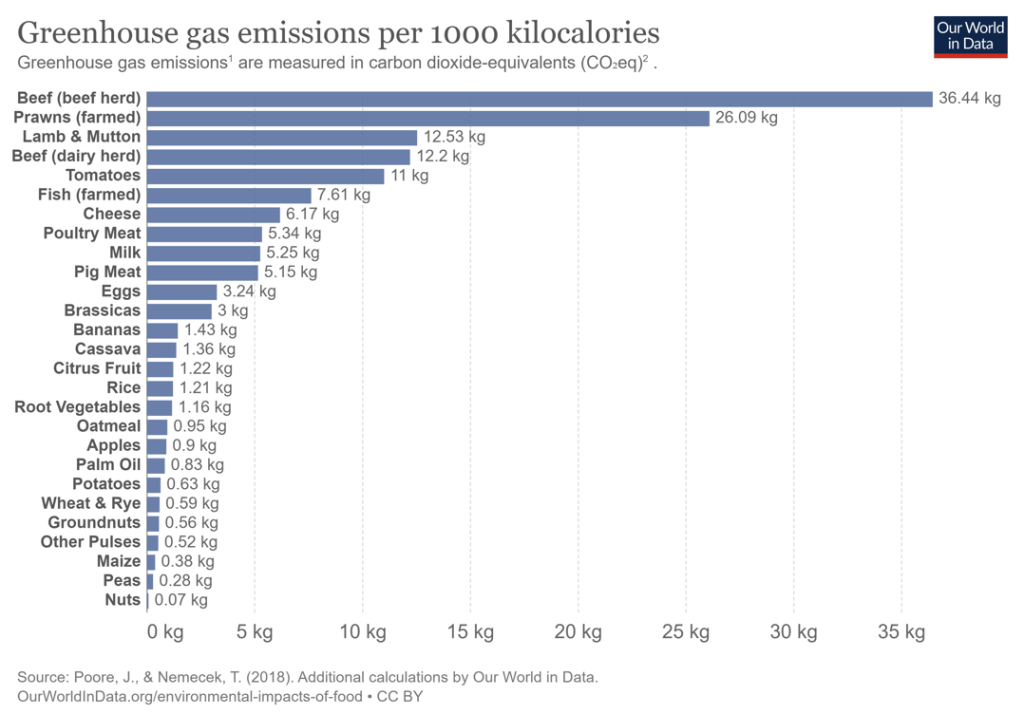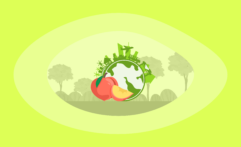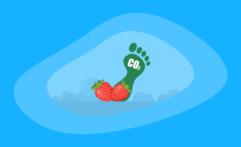What Is the Carbon Footprint of Limes? A Life-Cycle Analysis
Impactful Ninja is reader-supported. When you buy through links on our site, we may earn an affiliate commission.
Learn more
Learn more
.
Hey fellow impactful ninja ? You may have noticed that Impactful Ninja is all about providing helpful information to make a positive impact on the world and society. And that we love to link back to where we found all the information for each of our posts. Most of these links are informational-based for you to check out their primary sources with one click. But some of these links are so-called "affiliate links" to products that we recommend. First and foremost, because we believe that they add value to you. For example, when we wrote a post about the environmental impact of long showers, we came across an EPA recommendation to use WaterSense showerheads. So we linked to where you can find them. Or, for many of our posts, we also link to our favorite books on that topic so that you can get a much more holistic overview than one single blog post could provide. And when there is an affiliate program for these products, we sign up for it. For example, as Amazon Associates, we earn from qualifying purchases. First, and most importantly, we still only recommend products that we believe add value for you. When you buy something through one of our affiliate links, we may earn a small commission - but at no additional costs to you. And when you buy something through a link that is not an affiliate link, we won’t receive any commission but we’ll still be happy to have helped you. When we find products that we believe add value to you and the seller has an affiliate program, we sign up for it. When you buy something through one of our affiliate links, we may earn a small commission (at no extra costs to you). And at this point in time, all money is reinvested in sharing the most helpful content with you. This includes all operating costs for running this site and the content creation itself. You may have noticed by the way Impactful Ninja is operated that money is not the driving factor behind it. It is a passion project of mine and I love to share helpful information with you to make a positive impact on the world and society. However, it's a project in that I invest a lot of time and also quite some money. Eventually, my dream is to one day turn this passion project into my full-time job and provide even more helpful information. But that's still a long time to go. Stay impactful,Affiliate Disclosure
Why do we add these product links?
What do these affiliate links mean for you?
What do these affiliate links mean for us?
What does this mean for me personally?
![]()
Originating in Southeast Asia, limes have been a culinary staple for centuries. Today, they remain popular with over 23.5 million tons produced annually. In America, they are particularly famous as the prominent ingredient in the world-renowned key lime pie. But limes can also have an impact on the planet. Many resources that go into lime production can emit a lot of carbon. So we had to ask: What is the carbon footprint of limes?
The carbon footprint of limes is low at 0.18kg (0.39lb) of CO2e per pound of limes. This is mainly caused by their irrigation requirements, high use of pesticides, mechanized harvesting, and refrigerated transportation from Mexico.
In this article, we will look at the full life-cycle of limes, investigating how each stage contributes to their carbon footprint. We will go through all of the main stages of limes’ production—starting with growth and then going through harvesting, processing, transportation, and ending at waste disposal—and will evaluate how each stage contributes to limes’ carbon footprint. So, let’s get into the carbon footprint of limes!
Here’s How We Assessed the Carbon Footprint of Limes
The carbon footprint is one of the ways we measure the effects of our human-induced global climate change. It primarily focuses on the greenhouse gas (GHG) emissions associated with consumption, but also includes other emissions such as methane (CH4), nitrous oxide, and chlorofluorocarbons, and is generally expressed in carbon dioxide equivalents (CO2e).
“Carbon footprint: the amount of greenhouse gases and specifically carbon dioxide emitted by something (such as a person’s activities or a product’s manufacture and transport) during a given period”
Merriam Webster
Basically, it is the amount of carbon emitted by you as an individual or an organization providing you with goods and services – including limes:
- This includes GHG emissions from producing the products that we use and foods that we eat (e.g., power plants, factories or farms, and landfills)
- GHG emissions from fuel that we burn directly or indirectly (e.g., logistics and transportation, cooling or heating facilities),
- as well as the GHG emissions attributed to how we consume these products and foods.
To understand the carbon footprint of limes, we must assess its life-cycle and each stage’s sustainability. This life-cycle assessment (LCA) is a method to evaluate the environmental impacts of products and materials.
Here’s the Overall Carbon Footprint of Limes
The overall carbon footprint of limes is 0.18kg (0.39lb) of CO2e per pound of limes. The main factors that contribute to this are the use of pesticides and irrigation, as well as refrigerated transportation and low composting rates.
There are many things limes do right when it comes to their carbon footprint. For one, they have good land yields and don’t require too much packaging. Their production also comes from within North America, which cuts down on long transportation distances. However, there are still many factors that drive up their emissions.
| The carbon footprint of limes | 0.18kg (0.39lb) of CO2e per pound of limes |
So, let’s have a look at each stage of the LCA of limes!
| The life-cycle stages of limes | Each stage’s carbon footprint |
| Growing of limes | The carbon footprint of growing limes is high. This is largely due to their long growth duration, high irrigation requirements, and significant pesticide use. |
| Harvesting, processing, and packaging of limes | The carbon footprint of harvesting, processing, and packaging limes is generally high. This is because of their mechanized harvesting practices and refrigeration requirements during processing. |
| Transporting of limes | The carbon footprint of transporting limes is fairly high. The main causes are their international shipping from Mexico and use of refrigerated cargo containers. |
| End-of-life of limes | The carbon footprint of the end-of-life of limes is moderate. The biggest contributor to this is the low composting rates of organic waste. |
The stages that contribute the most to limes’ carbon footprint are growing and harvesting. These stages use a lot of resources, from irrigating the lime trees and spraying pesticides to mechanical harvesting practices. Transportation and end-of-life have smaller footprints, but still use refrigeration and suffer from low composting rates.
What Is the Carbon Footprint of Growing Limes
The carbon footprint of growing limes is high. This is largely due to their long growth duration, high irrigation requirements, and significant pesticide use.
The process of growing limes generally has a high carbon footprint, depending on the methods used. Factors like the amount of irrigation, deforestation, and pesticide use can all contribute to the overall impact of the growth stage.
Which factors impact the carbon footprint of growing limes?
- How do limes grow: Limes grow on trees in orchards. Trees store carbon exceptionally well. Thus, this stage contributes very minimally to the overall carbon footprint of limes.
- What is the growth duration of limes: The longer the growth frame, the higher the carbon footprint because more resources are required to sustain the plants. Lime trees take around 5–6 years to start producing fruit. This is a very long timeframe, considering lemons trees take about half that time. Furthermore, individual limes take around 6–9 months to grow. Based on these long timelines, growth duration contributes significantly to limes’ overall carbon footprint.
- What is the land usage of limes: When fruits use less land, they require less deforestation and resources to sustain them. Limes yield about 25 tons per hectare. This is a decent yield among fruits, which range from 2 tons per hectare to 100. Therefore, this stage contributes moderately to limes’ overall carbon footprint.
- What is the water usage of limes: Limes need about an inch of water per week. American limes are primarily grown in Mexico. Unfortunately, Mexico only gets around 28 inches of rain per year, under half the amount that limes need. Therefore, the rest of their water will need to be supplemented with irrigation. Irrigation has a high carbon footprint and so this stage contributes significantly to limes’ carbon footprint.
- What is the pesticide and fertilizer usage of limes: Limes tend to have high pesticide usage. In fact, many pesticides found on limes and other citrus fruits are particularly dangerous, with some being known carcinogens. Pesticides have a high carbon footprint, meaning that this stage contributes highly to limes’ carbon footprint.
The carbon sequestering properties of lime trees and the fairly economical land usage all work in limes’ favor during the growth stage. If you want to reduce your lime carbon footprint further, though, you should focus on buying organic limes to reduce pesticide use.
In short, the fact that limes take longer than other citrus fruits to grow, are farmed in regions unsuitable to their water needs, and use a lot of pesticides all culminate in a large growth carbon footprint.
What Is the Carbon Footprint of Harvesting, Processing, and Packaging Limes
The carbon footprint of harvesting, processing, and packaging limes is generally high. This is because of their mechanized harvesting practices and refrigeration requirements during processing.
The next major stage in the life-cycle of limes’ carbon emissions is harvesting, processing, and packaging. This involves picking the fruit, checking it for damage, sorting it, and getting it ready for distribution. This stage can contribute greatly to the carbon footprint of the fruit depending on the processes used.
Which factors impact the carbon footprint of harvesting, processing, and packaging limes?
- How are limes harvested: Limes are harvested both manually and mechanically. The mechanical method is known as “shake and catch.” This method involves a machine shaking the limes off the trees into a catching net. Since mechanical methods use energy to run, this stage contributes significantly to limes’ carbon footprint.
- How are limes processed: Limes are refrigerated immediately upon picking to extend shelf life. Refrigeration requires energy and so this stage also contributes significantly to limes’ carbon footprint.
- How are limes packaged: Limes usually don’t have any significant packaging. They are typically transported in crates. The minimal use of packaging means that this stage has a moderate carbon footprint.
Limes have minimal packaging at the consumer level. So, this has a positive impact on their carbon footprint. Unfortunately, when it comes to the mechanized processes during the farming stage, there is not much the average consumer can do to reduce their impact at this stage.
In short, limes are mechanically harvested and refrigerated. Therefore, their carbon footprint is high, despite their minimal packaging.
What Is the Carbon Footprint of Transporting Limes
The carbon footprint of transporting limes is fairly high. The main causes are their international shipping from Mexico and use of refrigerated cargo containers.
Limes’ journeys have just started when they are packaged. They then have to travel the distance between the farm and the grocery store. The distance, as well as the method through which they have to travel, are the two most important factors in determining the carbon footprint of their transportation.
Which factors impact the carbon footprint of transporting limes?
- Where are limes grown: Despite the significant Californian lime industry, this fruit tends to not grow as well in other parts of America as it does in Mexico. As a result, Mexican limes are larger. For this reason, the majority of limes consumed in the US are grown south of the border. International shipping significantly raises limes’ transportation emissions. However, the fact that Mexico is still in North America means that limes’ footprint is still lower than fruits that come from continents like Asia and Oceania. Given the medium international distance, this stage is a moderate contributor to limes’ carbon footprint.
- How are limes transported: Limes are primarily brought into the US through refrigerated containers on cargo ships. Refrigerated cargo containers have a higher carbon footprint than those used for dry goods. For this reason, the transportation method has a significant impact on limes’ carbon footprint.
Limes’ transportation emissions are not sky-high because they are still produced in North America. If you are willing, though, to eat smaller limes then consuming American-grown limes can cut down on your transportation emissions.
In short, the fact that limes come from an international, albeit North American, source and use refrigeration in their shipping means that their carbon footprint is fairly significant.
What Is the Carbon Footprint of the End-of-Life of Limes
The carbon footprint of the end-of-life of limes is moderate. The biggest contributor to this is the low composting rates of organic waste.
limes’ carbon footprint journey isn’t done after you consume them. In fact, one of the most important factors that will determine the overall carbon footprint of limes is how their waste is disposed of. Here, we will look at how this stage in the process affects limes’ carbon footprint.
Which factors impact the carbon footprint of the end-of-life of limes?
- How are limes disposed of: Limes have peels that are generally not eaten. These peels can technically be composted. But in practice, only around 4% of food is actually composted, the rest ending up in a landfill. Furthermore, when food waste is in landfills, it produces methane, a greenhouse gas. Therefore, organic waste contributes highly to limes’ carbon footprint.
- How is the packaging of limes disposed of: Limes do not have significant packaging, especially not at the consumer level. Thus, this stage does not contribute significantly to their carbon footprint.
Limes don’t have significant packaging and so their footprint can’t be too high at this stage. If you want to lower it further, you should make sure that you compost your lime peels.
In short, the fact that lime peels, and most food waste, don’t get composted drives up their carbon footprint. The lack of packaging, however, prevents this stage from being too high.
How Does the Carbon Footprint of Limes Compare to Other Types of Food
Limes have a fairly low carbon footprint when compared to other fruits by the pound. However, when kilocalories are taken into account, their lower calorie density puts them higher on the list in relation to other foods.
Limes have a low to moderate carbon footprint compared to other foods, depending on kilocalories. When assessing the carbon footprint of a particular food, it is always important to place it in the context of other foods. This can help you to see the relative impact they have and assist you in making decisions between different foods based on their carbon footprint. In this next part of the article, we will show you how limes compare to other foods in terms of carbon footprint.
How Does the Carbon Footprint of Limes Compare to Other Types of Fruits
Limes have a fairly low carbon footprint compared to other fruits. Fruits in general, tend to have lower carbon footprints than many other foods, like dairy products. However, there is still a lot of variation between them. Different transportation distances, the density of orchards, variations in growing methods, and pesticide use can all add up to contribute to their carbon footprints. Here, we will look at how limes compare specifically to other fruits in terms of carbon footprint.
| Fruits | Carbon Footprint per lbs | Calories per lbs | Carbon Footprint per Calories |
| Avocados | 0.85 kg (1.9 lb) of CO2e per pound of avocados | 725 calories per pound | 1.17kg (2.57lb) of CO2e per 1,000 calories of avocados |
| Grapes | 0.64 kg (1.42 lbs) of CO2e per pound of grapes | 300 calories per pound | 2.13kg (4.7lb) of CO2e per 1,000 calories of grapes |
| Cantaloupe | 0.58kg (1.3lb) of CO2e per pound of cantaloupe | 154 calories per pound | 3.77kg (8.31lb) of CO2e per 1,000 calories of cantaloupes |
| Kiwis | 0.56kg (1.24lb) of CO2e per pound of kiwis | 277 calories per pound | 2.02kg (4.45lb) of CO2e per 1,000 calories of kiwis |
| Blueberries | 0.45kg (1lb) of CO2e per pound of blueberries | 256 calories per pound | 1.75kg (3.86lb) of CO2e per 1,000 calories of blueberries |
| Plums | 0.4 kg (0.88 lb) CO2e per pound of plums | 209 calories per pound | 1.91kg (4.21lb) of CO2e per 1,000 calories of plums |
| Strawberries | 0.39kg (0.88lb) of CO2e per pound of strawberries | 145 calories per pound | 2.69kg (5.93lb) of CO2e per 1,000 calories of strawberries |
| Pomegranates | 0.39kg (0.87lb) of CO2e per pound of pomegranates | 375 calories per pound | 1.04kg (2.29lb) of CO2e per pound of pomegranates |
| Figs | 0.3kg (0.68lb) of CO2e per pound of figs | 333 calories per pound | 0.9kg (1.98lb) of CO2e per 1,000 calories of figs |
| Papayas | 0.3kg (0.67lb) of CO2e per pound of papayas | 195 calories per pound | 1.54kg (3.4lb) of CO2e per 1,000 calories of papayas |
| Oranges | 0.3kg (0.66 lb) CO2e per pound of oranges | 213 calories per pound | 1.41kg (3.11lb) of CO2e per 1,000 calories of oranges |
| Dates | 0.27kg (0.6lb) of CO2e per pound of dates | 1,300 calories per pound | 0.21kg (0.46lb) of CO2e per 1,000 calories of dates |
| Apples | 0.24 kg (0.53 lb) of CO2e per pound of apples | 236 calories per pound | 1.02kg (2.25lb) of CO2e per 1,000 calories of apples |
| Pears | 0.23kg (0.52 lb) of CO2e per pound of pears | 259 calories per pound | 0.89kg (1.96lb) of CO2e per 1,000 calories of pears |
| Bananas | 0.21 kg (0.48 lb) of CO2e per pound of banana | 404 calories per pound | 0.52kg (1.15lb) of CO2e per 1,000 calories of bananas |
| Mangoes | 0.21 kg (0.46 lb) CO2e per pound of mangoes | 272 calories per pound | 0.77lb (1.7lb) of CO2e per 1,000 calories of mangoes |
| Cherries | 0.19kg (0.41 lb) of CO2e per pound of cherries | 227 calories per pound | 0.84kg (1.85lb) of CO2e per 1,000 calories of cherries |
| Limes | 0.18kg (0.39lb) of CO2e per pound of limes | 136 calories per pound | 1.32kg (2.91lb) of CO2e per 1,000 calories of limes |
| Peaches | 0.17kg (0.38lb) CO2e per pound of peaches | 176 calories per pound | 0.97kg (2.14lb) of CO2e per 1,000 calories of peaches |
| Apricots | 0.16kg (0.36lb) of CO2e per pound of apricots | 218 calories per pound | 0.73kg (1.61lb) of CO2e per 1,000 calories of apricots |
| Raspberries | 0.15kg (0.33lb) of CO2e per pound of raspberries | 240 calories per pound | 0.63kg (1.39lb) of CO2e per 1,000 calories of raspberries |
| Pineapples | 0.09 kg (0.20 lb) of CO2e per pound of pineapple | 227 calories per pound | 0.4kg (0.88lb) of CO2e per 1,000 calories of pineapples |
| Lemons | 0.09kg (0.19lb) CO2e per pound of lemons | 132 calories per pound | 0.68kg (1.5lb) of CO2e per 1,000 calories of lemons |
| Grapefruit | 0.08kg (0.18lb) of CO2e per pound of grapefruit | 191 calories per pound | 0.42kg (0.93lb) of CO2e per 1,000 calories of grapefruits |
| Blackberries | 0.07kg (0.15lb) of CO2e per pound of blackberries | 195 calories per pound | 0.36kg (0.79lb) of CO2e per 1,000 calories of blackberries |
| Clementines | 0.06 kg (0.13 lb) CO2e per pound of clementines | 213 calories per pound | 0.28kg (0.62kg) of CO2e per 1,000 calories of clementines |
| Watermelons | 0.05kg (0.11 lb) of CO2e per pound of watermelon | 136 calories per pound | 0.37kg (0.82lb) of CO2e per 1,000 calories of watermelons |
Compared to other fruits on this list, we can see that limes rank moderate to low. They rank in the middle amongst citrus fruits, with double the emissions of lemons but almost half the emissions of oranges. Though they are much lower than the worst offenders, there are still fruits like clementines and watermelons which have less than a third the emissions of limes. However, they are well below the average of 2.7 and so overall are a fairly carbon-conscious fruit.
How Does the Carbon Footprint of Limes Compare to Other Types of Food in General
Limes rank moderately on the list of foods when you consider kilocalories. Limes have a lower calorie density than many other foods on this list, which means that their footprint is going to be higher per calorie than it would be per pound.
When it comes to greenhouse gas emissions (GHG), foods are often compared in terms of emissions per 1,000 kilocalories (as opposed to their weight in lbs or kg).

When we compare limes to the larger category of foods, we can see that they fall in the lower middle.
- Citrus in general has a low carbon footprint per pound, but when we take kilocalories into account, limes and other citrus are not as efficient as other fruits.
- Limes have around 130 calories per pound, whereas bananas have around 400.
- Therefore, when kilocalories are taken into account, limes have a higher carbon footprint.
How Can You Reduce and Offset Your Personal Carbon Footprint
There are many things you can do to cut down on how your lime consumption impacts the planet. By carefully considering your consumption habits to reduce carbon emissions and offsetting your carbon through carbon-extraction schemes, you can consume lime without having a large negative impact on the earth.
Some of the carbon risks of limes highlighted in this article may be a little concerning. However, the good news is that there are a lot of things you can do to lower your carbon emissions while still eating limes. Purchasing organic or locally-grown limes and disposing of the waste efficiently can help with this. Furthermore, you can consider emission offsets, which work to extract carbon from the atmosphere. Here, we will walk you through how to accomplish both of these things.
How Can You Reduce Your Carbon Footprint When Shopping for Limes
Before you start worrying about your offsets, you might be wondering how you can stop producing carbon in the first place through your lime consumption. One of the best ways to do this is to look at the parts of the lime process that have the highest carbon footprint and start there. In this section, we give you a short list of ways you can reduce your lime carbon footprint, so you can continue consuming limes without the high carbon price tag.
- Purchase US limes: Though the quality and size of US limes might be inferior to Mexican limes, their climate benefits speak for themselves. Buying limes grown in the US, and preferably as close to your city as possible, will cut down on transportation distances and therefore emissions.
- Purchase organic limes: Pesticides are a major contributor to limes’ carbon footprint, and so you should try to cut down on these as much as possible. Organic farms commit to avoiding chemicals. If you try to buy limes from organic farms, you will thus be greatly reducing your pesticide-related emissions.
- Compost lime peels: Food waste ending up in landfills is a big problem for the planet. If you make the effort to compost your lime peels, then you will avoid them ending up in the landfill. If your city doesn’t provide composting, you can consider creating your own.
- Use lime peels: If you don’t want to compost, you can also consider using the whole lime so nothing goes to waste. Lime zest is a popular ingredient in baking and cocktails. You can even make lime peels into candy!
Following some of these methods can really help you to cut down on your lime carbon emissions. None of these will bring your emissions down to zero, since there are always hidden carbon costs that may be outside of your control. But reduction is always better than nothing! However, if you do want to get your lime emissions down to absolute zero, then you can look into carbon offsets.
How Can You Offset Your Personal Carbon Footprint
Carbon offsets are reductions in carbon emissions that are used to compensate for carbon emissions occurring elsewhere – for example for the carbon emissions that are associated with limes. They are measured in tons of CO2 equivalents and are bought and sold through international brokers, online retailers, and trading platforms on what is known as the global carbon offset market.
“Carbon Offset: a way for a company or person to reduce the level of carbon dioxide for which they are responsible by paying money to a company that works to reduce the total amount produced in the world, for example by planting trees”
Oxford Dictionary
In terms of limes – and indeed all food types – there will always be a carbon footprint, because of the resources it takes to get your food from farms to the place where you’ll eventually eat them. And while there are ways to reduce your carbon footprint when shopping for limes, carbon offsets would be a way to reduce your CO2e emissions all the way down to net zero (or even to become climate positive).
However, when you purchase carbon offsets, it’s important that they actually make a difference in offsetting (aka reducing) total carbon emissions. To achieve that, the following are key criteria:
- Carbon offset projects have to be effective (different projects have different effectiveness rates)
- Carbon offset projects have to be additional
- Carbon offset projects have to be permanent
- The claims from carbon offset projects have to be verifiable
To find the best carbon offsets for you personally, check out our full guide on the best carbon offsets for individuals, where you’ll also learn more about how these carbon offset projects work, what their respective offsetting costs are, and what your best way would be to offset your own carbon emissions.
Final Thoughts
Limes are a versatile and delicious fruit, but as we have seen, they can have some carbon costs. Though they do a lot of things right, like decent land yields and minimal packaging, there are many parts of the process that come with a high carbon price tag. From international refrigerated shipping to high pesticide use, there are a lot of things that limes could improve on. Buying local and organic limes, as well as composting or making use of the peels can really help you to reduce this carbon footprint.
Stay impactful,

Sources
- The Fact Site: Lime Facts
- BBC Good Food: Key Lime Pie Recipe
- Tridge: Fresh Lime Production and Lime Producing Countries
- Britannica: Carbon footprint
- Science Direct: Life-cycle assessment (LCA)
- MIT SMR: Strategic Sustainability Uses of Life-Cycle Analysis
- Chec International: The 10 Best Foods to Eat for Greenhouse Gas Emissions
- Agrifarming: Lime Farming
- Woodland Trust: How Trees Capture and Store Carbon
- Daltons: Lime Tree Fruiting
- Green Upside: When Does a Lemon Tree Bear Fruit
- Hunker: How Long Does it Take for a Lime Tree to Bloom & Fruit
- Horticulture: Fruit Crops
- Impactful Ninja: What is the Carbon Footprint of Watermelons
- Impactful Ninja; What is the Carbon Footprint of Bananas
- Plantly: Lime Tree
- USDA: Fresh Market Limes
- Climatology: Mexico
- Science Direct: Energy and Carbon Footprint of Irrigation
- EWG: Citrus
- Pesticide.org: Pesticides and the Climate Crisis
- Nepad: Harvesting Citrus Fruits
- Research Gate: Post-Harvest Storing of Lime Fruits
- TIS.GOV: Lime Transport Information
- Searoutes: Decarbonizing Ocean Container Transport
- EPA: Reducing the Impact of Wasted Food
- GOV.BC: Waste Management
- Impactful Ninja: What is the Carbon Footprint of Avocados
- Impactful Ninja: What is the Carbon Footprint of Cantaloupes
- Impactful Ninja: What is the Carbon Footprint of Blueberries
- Helabel: Kiwis
- Impactful Ninja: What is the Carbon Footprint of Plums
- Impactful Ninja: What is the Carbon Footprint of Strawberries
- Impactful Ninja: What is the Carbon Footprint of Oranges
- Impactful Ninja: What is the Carbon Footprint of Apples
- Impactful Ninja: What is the Carbon Footprint of Pears
- Impactful Ninja: What is the Carbon Footprint of Mangoes
- Impactful Ninja: What is the Carbon Footprint of Cherries
- Impactful Ninja: What is the Carbon Footprint of Peaches
- Impactful Ninja: What is the Carbon Footprint of Raspberries
- Impactful Ninja; What is the Carbon Footprint of Pineapples
- Impactful Ninja: What is the Carbon Footprint of Lemons
- Cambridge: Resource Use and GHG Emissions of Eight Tropical Fruit Species
- Impactful Ninja; What is the Carbon Footprint of Clementines
- Our World in Data: Greenhouse Gas Emissions per 1000 kilocalories
- USDA: Limes
- USDA: Bananas
- Earth Easy: How to Make Compost Using Tumblers and Bins
- Baking Mad: Iced Lime Tray Bake
- Diffords Guide: The Business Cocktail
- Martha Stewart: Candied Lime Peel
- Impactful Ninja: Best Carbon Offsets for Individuals




